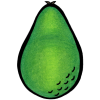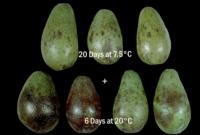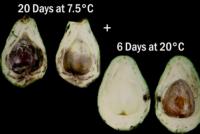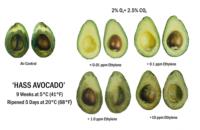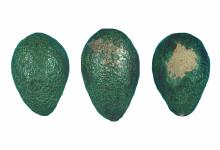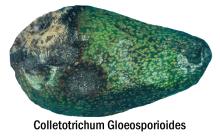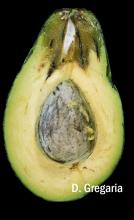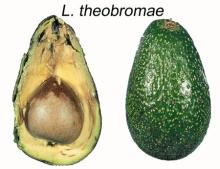Product Description
Maturity and Quality
Percent of dry matter is highly correlated with oil content and is used as a maturity index in California and most other avocado production areas; minimum dry matter required ranges from 19 to 25%, depending on cultivar (19.0% for 'Fuerte', 20.8% for 'Hass', and 24.2% for 'Gwen').
Florida-grown avocado cultivars have lower oil content and are harvested on the basis of a calendar date (days after full bloom).
- Size (range of consumer preference)
- Shape (cultivar-dependent)
- Skin color
- Freedom from defects such as misshapen, sunburn, wounds and skin blemishes (rubs, insect damage, hail, and wind scars), rancidity and flesh browning
- Freedom from disease, including anthracnose and stem-end rot
- Some cultivars are held on the tree for extended periods after achieving horticultural maturity
- On-tree storage may result in development of off-flavors or rancidity with overmaturity
- Off-flavors may also develop when fruit are harvested during periods of hot weather
Postharvest Handling and Storage
5-13°C (41-55°F) for mature-green avocados, depending on cultivar and duration. 2-4°C (36-40°F) for ripe avocados.
| Temperature | 5°C (41°F) | 10°C (50°F) | 20°C (68°F) |
|---|---|---|---|
| ml CO2/kg·hr | 10-25 | 25-80 | 40-150 |
To calculate heat production multiply ml CO2/kg·hr by 440 to get Btu/ton/ day or by 122 to get kcal/metric ton/day.
Treatment with 100ppm ethylene at 20°C (68°F) for 48 hours (early-season fruits), 24 hours (mid-season fruits), or 12 hours (late-season fruits) induces avocados to ripen in 3-6 days, depending on cultivar and maturity. Ripening indices include flesh softening and change of skin color from green to black in some cultivars such as 'Hass'. Ripe (soft) avocados require care in handling to minimize physical damage.
90-95%
Avocado fruits do not ripen on the tree and ethylene production begins after harvest and increases greatly with ripening to > 100µl C2H4/kg·hr at 20°C (68°F).
- Optimum CA (2-5% O2 and 3-10% CO2) delay softening and skin color changes and reduce respiration and ethylene production rates
- CA reduces chilling injury of avocado. Mature-green 'Hass' avocado can be kept at 5-7°C (41-45°F) in 2% O2 and 3-5% CO2 for 9 weeks, then ripened in air at 20°C (68°F) to good quality. Exclusion and/or removal of ethylene from CA storage are recommended
- >10% CO2 may increase skin and flesh discoloration and off-flavor development, especially when O2 is <1%
Temperature & Controlled Atmosphere Photos
Disorders
Chilling injury. Skin pitting, scalding, and blackening are the main external chilling injury symptoms on mature-green avocado kept at 0-2°C (32-36°F) for more than 7 days before transfer to ripening temperatures. Avocados exposed to 3-5°C (37-41°F) for more than two weeks may exhibit internal flesh browning (gray pulp, pulp spot, vascular browning), failure to ripen, and increased susceptibility to pathogen attack. The timing of chilling injury development and its severity depend on cultivar, production area, and maturity-ripeness stage.
Anthracnose. Caused by Colletotrichum gloeosporioides and appears as the fruit begins to soften as circular black spots covered with pinkish spore masses in later stages. Decay can penetrate through the flesh and induce browning and rancid flavor.
Stem-end rot. Caused by Botryodiplodia theobromae and appears as dark-brown to black discoloration which begins at the stem and advances toward the blossom end, finally covering the entire fruit. Dothiorella gregaria is another cause of stem-end rot in ripe avocados.
Control Strategies
Control methods include good orchard sanitation, effective preharvest fungicide application, careful handling to minimize physical injuries, prompt cooling to optimum temperature for the cultivar and maintaining that temperature during marketing.
Insect Control
- Cold treatment (1°C for 14 days) can be tolerated without chilling injury if avocados are conditioned for 12-18 hours at 38°C before the cold treatment
- Avocados do not tolerate heat treatments and/or controlled atmospheres needed for insect control
[For more information, see our publication "Fruit Ripening and Ethylene Management", available for purchase using our Publication order form.]



